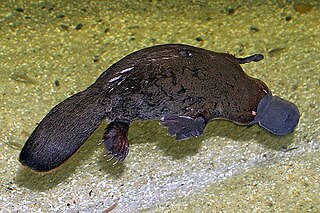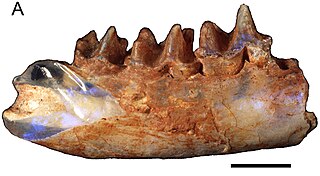
The platypus, sometimes referred to as the duck-billed platypus, is a semiaquatic, egg-laying mammal endemic to eastern Australia, including Tasmania. The platypus is the sole living representative or monotypic taxon of its family Ornithorhynchidae and genus Ornithorhynchus, though a number of related species appear in the fossil record.

The order Peramelemorphia includes the bandicoots and bilbies. All members of the order are endemic to Australia-New Guinea and most have the characteristic bandicoot shape: a plump, arch-backed body with a long, delicately tapering snout, very large upright ears, relatively long, thin legs, and a thin tail. Their size varies from about 140 grams up to 4 kilograms, but most species are about one kilogram.

The Ornithorhynchidae are one of the two extant families in the order Monotremata, and contain the platypus and its extinct relatives. The other family is the Tachyglossidae, or echidnas.

Kollikodon is an extinct species of mammal, considered to be an early monotreme. It is known only from an opalised dentary fragment, with one premolar and two molars in situ, as well as a referred maxillary fragment containing the last premolar and all four molars. The fossils were found in the Griman Creek Formation at Lightning Ridge, New South Wales, Australia. Kollikodon lived in the Late Cretaceous period, during the Cenomanian age. Several other monotremes are known from the Griman Creek Formation, including Dharragarra, Opalios, Parvopalus, Steropodon, and Stirtodon.

Steropodon is a genus of prehistoric platypus-like monotreme, or egg-laying mammal. It contains a single species, Steropodon galmani, that lived about 100.2–96.6 million years ago during the Cretaceous period, from early to middle Cenomanian. It is one of the oldest monotremes discovered, and is one of the oldest Australian mammal discoveries. Several other monotremes are known from the Griman Creek Formation, including Dharragarra, Kollikodon, Opalios, Parvopalus, and Stirtodon.
Teinolophos is a prehistoric species of monotreme, or egg-laying mammal, from the Teinolophidae. It is known from four specimens, each consisting of a partial lower jawbone collected from the Wonthaggi Formation at Flat Rocks, Victoria, Australia. It lived during the late Barremian age of the Lower Cretaceous.

Riversleigh World Heritage Area is Australia's most famous fossil location, recognised for the series of well preserved fossils deposited from the Late Oligocene to more recent geological periods. The fossiliferous limestone system is located near the Gregory River in the north-west of Queensland, an environment that was once a very wet rainforest that became more arid as the Gondwanan land masses separated and the Australian continent moved north. The approximately 100 square kilometres (39 sq mi) area has fossil remains of ancient mammals, birds, and reptiles of the Oligocene and Miocene ages, many of which were discovered and are only known from the Riversleigh area; the species that have occurred there are known as the Riversleigh fauna.

Mekosuchus is a genus of extinct Australasian mekosuchine crocodilian. Species of Mekosuchus were generally small-sized, terrestrial animals with short, blunt-snouted heads and strong limbs. Four species are currently recognized, M. inexpectatus, M. whitehunterensis, M. sanderi and M. kalpokasi, all known primarily from fragmentary remains.

Wakaleo is an extinct genus of medium-sized thylacoleonids that lived in Australia in the Late Oligocene and Miocene Epochs.

The Australosphenida are a clade of mammals, containing mammals with tribosphenic molars, known from the Jurassic to Mid-Cretaceous of Gondwana. Although they have often been suggested to have acquired tribosphenic molars independently from those of Tribosphenida, this has been disputed. Fossils of australosphenidans have been found from the Jurassic of Madagascar and Argentina, and Cretaceous of Australia and Argentina. Monotremes have also been considered a part of this group in its original definition and in many subsequent studies, but its relationship with the relationship with other members has been disputed by some scholars.

The genus Nimbacinus contains two species of carnivorous, quadrupedal marsupials in Australia both of which are extinct:

Monotremes are mammals of the order Monotremata. They are the only known group of living mammals that lay eggs, rather than bearing live young. The extant monotreme species are the platypus and the four species of echidnas. Monotremes are typified by structural differences in their brains, jaws, digestive tract, reproductive tract, and other body parts, compared to the more common mammalian types. Although they are different from almost all mammals in that they lay eggs, like all mammals, the female monotremes nurse their young with milk.
Wabulacinus ridei lived during the early Miocene in Riversleigh. It is named after David Ride, who made the first revision of thylacinid fossils. The material was found in system C of the Camel Spurtum assembledge.
Several mammals are known from the Mesozoic of Madagascar. The Bathonian Ambondro, known from a piece of jaw with three teeth, is the earliest known mammal with molars showing the modern, tribosphenic pattern that is characteristic of marsupial and placental mammals. Interpretations of its affinities have differed; one proposal places it in a group known as Australosphenida with other Mesozoic tribosphenic mammals from the southern continents (Gondwana) as well as the monotremes, while others favor closer affinities with northern (Laurasian) tribosphenic mammals or specifically with placentals. At least five species are known from the Maastrichtian, including a yet undescribed species known from a nearly complete skeleton that may represent a completely new group of mammals. The gondwanathere Lavanify, known from two teeth, is most closely related to other gondwanatheres found in India and Argentina. Two other teeth may represent another gondwanathere or a different kind of mammal. One molar fragment is one of the few known remains of a multituberculate mammal from Gondwana and another has been interpreted as either a marsupial or a placental.
Malleodectes is an extinct genus of unusual marsupial, first discovered in 2011 at Riversleigh, Queensland, Australia.

Yinotheria is a proposed basal subclass clade of crown mammals uniting the Shuotheriidae, an extinct group of mammals from the Jurassic of Eurasia, with Australosphenida, a group of mammals known from the Jurassic to Cretaceous of Gondwana, which possibly include living monotremes. Today, there are only five surviving species of monotremes which live in Australia and New Guinea, consisting of the platypus and four species of echidna. Fossils of yinotheres have been found in Britain, China, Russia, Madagascar and Argentina. Contrary to other known crown mammals, they retained postdentary bones as shown by the presence of a postdentary trough. The extant members (monotremes) developed the mammalian middle ear independently.

Microleo attenboroughi is a very small species of the Thylacoleonidae family of marsupials from the Early Miocene of Australia, living in the wet forest that dominated Riversleigh about 18 million years ago. The genus Microleo is currently known from a broken palate and two pieces of jaw, containing some teeth and roots that correspond to those found in other species of thylacoleonids. The shape and structure of the blade-like P3 tooth, a premolar, distinguished the species as a new genus. It was found in Early Miocene-aged deposits of the Riversleigh fossil site in Queensland, regarded as one of the most significant palaeontological sites yet discovered, and named for the naturalist David Attenborough in appreciation of his support for its heritage listing. The anatomy of Microleo suggests the genus is basal to all the known thylacoleonids, known as the marsupial lions, although its relative size prompted one discoverer to describe it as the "feisty" kitten of the family.
Brevipalatus mcculloughi is a species of bat that existed in the early Miocene. It was discovered at a fossil deposit of the Riversleigh World Heritage Area.
Liyamayi dayi is a mammal species of the Thylacomyidae family known from fossils located at the Riversleigh World Heritage Area in northeast Australia. The discovery of the specimens was identified as deposited around fifteen million years ago, revising the earliest record of this peramelemorphian lineage from those of species that existed around ten million years later.
Teinolophidae is an extinct family of small mammals that are among the earliest known monotremes and were endemic to what would become Australia. Two genera have been described as belonging to this family: Teinolophos, and Stirtodon.












